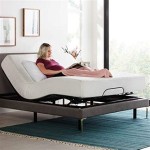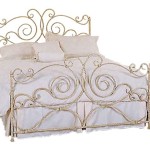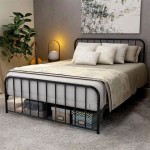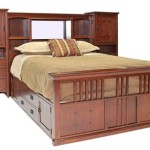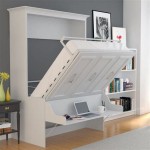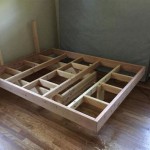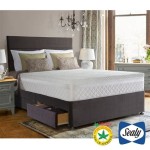Queen Size Floating Bed Frame DIY
A floating bed frame provides a modern, minimalist aesthetic, creating the illusion of a bed suspended in mid-air. Building a queen-size floating bed frame is a challenging but rewarding DIY project that can significantly enhance a bedroom's visual appeal while potentially saving money compared to purchasing a pre-built option. This article will outline the steps and considerations involved in constructing such a frame.
Planning and Preparation: Before beginning construction, meticulous planning is essential. Accurate measurements are crucial. Standard queen-size mattress dimensions are 60 inches wide by 80 inches long, but variations exist. Measure the specific mattress to be used to ensure a perfect fit. Determining the desired height of the bed from the floor is also important. A typical height ranges from 12 to 18 inches, allowing sufficient space for under-bed storage while maintaining a comfortable entry and exit point.
Material Selection: The choice of materials impacts the frame's strength, durability, and overall aesthetic. High-quality lumber is recommended for the frame's construction. Kiln-dried lumber minimizes warping and cracking. Popular choices include hardwood options like maple or oak for their strength and aesthetic appeal, or more affordable softwoods like pine or fir, which can be stained or painted to achieve a desired finish. Plywood can be used for the platform supporting the mattress. The thickness of the plywood should be chosen based on the combined weight of the mattress and anticipated load. Metal brackets, screws, and wood glue are also necessary for assembly.
Construction Process: The core of the floating bed frame illusion lies in a central support structure hidden from view. This structure bears the weight of the mattress and sleepers. One method involves building a rectangular frame from the chosen lumber, slightly smaller than the mattress dimensions. This frame rests on a series of shorter vertical supports, creating the "floating" effect. The vertical supports are connected to a larger outer frame that forms the visible perimeter of the bed. This outer frame should extend beyond the inner frame, creating the illusion that the bed platform floats within it.
Reinforcement and Stability: Reinforcing the frame is critical for stability and safety. Metal brackets at the joints between the inner and outer frames, as well as at the connections with the vertical supports, significantly increase the structure's rigidity. Wood glue should be used in conjunction with screws for added strength. Central support beams running the length of the bed within the inner frame can further distribute weight and prevent sagging.
Creating the Platform: Once the supporting frame is assembled and reinforced, the platform for the mattress can be constructed. A sheet of plywood cut to the exact dimensions of the inner frame provides a solid, even surface. This plywood sheet is secured to the inner frame using screws and wood glue. The plywood can be covered with upholstery foam and fabric for added comfort and a cleaner finish, though this step is optional.
Finishing Touches: After the platform is complete, the frame can be finished to match existing décor. Sanding smooths any rough edges and prepares the wood for staining or painting. Applying multiple coats of stain or paint, allowing sufficient drying time between each coat, provides a durable and visually appealing finish. Consider adding LED lighting strips to the underside of the frame to enhance the floating effect, especially in dimly lit rooms.
Safety Considerations: Throughout the construction process, prioritizing safety is paramount. Using appropriate safety equipment, such as eye protection and gloves, is crucial. Ensuring the frame is level and stable after assembly is essential for preventing accidents. Regularly inspecting the frame for signs of wear or damage and addressing any issues promptly can maintain the bed's structural integrity and ensure long-term safety.
Customization and Variations: The basic design outlined above can be adapted and customized to suit individual preferences and needs. The height of the bed, the materials used, and the finishing touches can all be modified. Integrating built-in storage drawers into the space beneath the frame is a practical modification that maximizes space utilization. The outer frame can be designed with various styles and details to complement the existing bedroom décor, from sleek and minimalist to ornate and decorative.
Cost Considerations: Building a DIY floating bed frame can be more cost-effective than buying a pre-built option, particularly when using readily available and affordable materials. However, the final cost depends on the chosen materials, the complexity of the design, and any additional features incorporated. Carefully researching material prices and comparing them to pre-built options can help determine the most economical approach.

Diy Queen Size Floating Bed Howtospecialist How To Build Step By Plans Frame

How To Build A Diy Floating Bed For Queen Size Mattress Thediyplan

Floating Queen Size Platform Bed Plans Howtospecialist How To Build Step By Diy Frame

Diy Queen Size Floating Bed Howtospecialist How To Build Step By Plans

King Size Floating Bed Frame Easily Build Your Own

Floating Queen Size Platform Bed Plans Howtospecialist How To Build Step By Diy Frame

Floating Bed For Queen Size Mattress Thediyplan

Diy Floating Bed Frames How To Design Plan And Build Them From Scratch

Queen Size Floating Bed Plans

Diy Floating Bed Frames How To Design Plan And Build Them From Scratch
